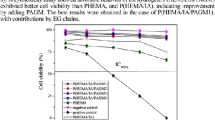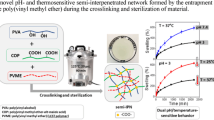Abstract
We developed a pH-responsive, hydrogel based on poly(ethylene glycol) (PEG) covalently cross-linked with acrylic acid and N′,N′-dimethylacrylamide along with acid-labile groups. In the hydrogel, PEG plays a role as the key constituent. If its chains break, the polymer networks are destroyed. The pharmacological potential of these hydrogels were demonstrated by determining their water transport profile, modulus of elasticity, and cytotoxicity assay. The hydrogels showed a pseudo-Fickian behavior, a transport mechanism that occurs when the diffusion coefficient changes with the time and the swelling equilibrium is never fully reached. At pH 2, the PEG-richer hydrogels degraded and the scanning electron microscopy (SEM) images illustrated less-defined shapes than at pH 7 and 10. This morphological characteristic results of the hydrogel deconstruction owing to cleavage of ether bonds of the PEG chains unmaking its 3D polymer network. The proposed hydrogels were shown to be compatible to cells, indicating acceptable biocompatibility and an appropriate level of security for use in the biological environments. Furthermore, they showed structural changes in their polymer network in response to pH, which is an important characteristic for stimuli-triggered release of guest molecules.










Similar content being viewed by others
References
Amidon GL, Lee PI, Topp EM (2000) Transport process in pharmaceutical systems. In: Gehrke SH (ed) Synthesis and properties of hydrogels used for drug delivery. Marcel Dekker, Inc, New York, Cap 13
Warson H (2000) Modern superabsorbent polymer technology. Polym Int 49:1548–1548. doi:https://doi.org/10.1002/1097-0126(200011)49:11<1548::AID-PI482>3.0.CO;2-D
Tajima H, Yoshida Y, Abiko S, Yamagiwa K (2010) Size adjustment of spherical temperature-sensitive hydrogel beads by liquid–liquid dispersion using a Kenics static mixer. Chem Eng J 156:479–486. doi:https://doi.org/10.1016/j.cej.2009.11.010
Li Z, Shen J, Ma H, Lu X, Shi M, Li N, Ye M (2013) Preparation and characterization of pH- and temperature-responsive nanocomposite double network hydrogels. Mater Sci Eng C 33:1951–1957. doi:https://doi.org/10.1016/j.msec.2013.01.004
Chen J, Liu M, Liu H, Ma L, Gao C, Zhu S, Zhang S (2010) Synthesis and properties of thermo- and pH-sensitive poly(diallyldimethylammonium chloride)/poly(N, N-diethylacrylamide) semi-IPN hydrogel. Chem Eng J 159:247–256. doi:https://doi.org/10.1016/j.cej.2010.02.034
Liu HQ, Zhen M, Wu RH (2007) Ionic-strength- and pH-responsive poly acrylamide-co-(maleilc acid) hydrogel nanofibers. Macromol Chem Phys 208:874–880. doi:https://doi.org/10.1002/macp.200600632
Althans D, Schrader P, Enders S (2014) Solubilisation of quercetin: comparison of hyperbranched polymer and hydrogel. J Mol Liq 196:86–93. doi:https://doi.org/10.1016/j.molliq.2014.03.028
Valade D, Wong LK, Jeon YJ, Jia ZF (2013) Monteiro M. J.: polyacrylamide hydrogel membranes with controlled pore sizes. J Polym Sci Part A: Polym Chem 51:129–138. doi:https://doi.org/10.1002/pola.26311
Hertz J, Robinson R, Valenzuela DA, Layik EB, Goldberg JL (2013) A tunable synthetic hydrogel system for culture of retinal ganglion cells and amacrine cells. Acta Biomater 9:7622–7629. doi:https://doi.org/10.1016/j.actbio.2013.04.048
Wu YB, Wei W, Zhou M, Wang YQ, Wu J, Ma GH, Su ZG (2012) Thermal-sensitive hydrogel as adjuvant-free vaccine delivery system for H5N1 intranasal immunization. Biomaterials 33:2351–2360. doi:https://doi.org/10.1016/j.biomaterials.2011.11.068
Truong V, Blakey I, Whittaker AK (2012) Hydrophilic and amphiphilic polyethylene glycol-based hydrogels with tunable degradability prepared by “Click” chemistry. Biomacromolecules 13:4012–4021. doi:https://doi.org/10.1021/bm3012924
Kono H (2014) Characterization and properties of carboxymethyl cellulose hydrogels crosslinked by polyethylene glycol. Carbohydr Polym 106:84–93. doi:https://doi.org/10.1016/j.carbpol.2014.02.020
Gavira JA, Cera-Manjarres A, Ortiz K, Mendez J, Jimenez-Torres JA, Patino-Lopez LD, Torres-Lugo M (2014) Use of cross-linked poly(ethylene glycol)-based hydrogels for protein crystallization. Crystal Growth Design 14:3239–3248. doi:https://doi.org/10.1021/cg401668z
Nguyen MK, Alsberg E (2014) Bioactive factor delivery strategies from engineered polymer hydrogels for therapeutic medicine. Prog Polym Sci 39:1235–1265. doi:https://doi.org/10.1016/j.progpolymsci.2013.12.001
Nguyen MK, Jeon O, Krebs MD, Schapira D, Alsberg E (2014) Sustained localized presentation of RNA interfering molecules from in situ forming hydrogels to guide stem cell osteogenic differentiation. Biomaterials 35:6278–6286. doi:https://doi.org/10.1016/j.biomaterials.2014.04.048
Chen Z, Zhao M, Liu K, Wan YQ, Li XD, Feng G (2014) Novel chitosan hydrogel formed by ethylene glycol chitosan, 1,6-diisocyanatohexan and polyethylene glycol-400 for tissue engineering scaffold: in vitro and in vivo evaluation. J Mater Sci Mater Med 25:1903–1913. doi:https://doi.org/10.1007/s10856-014-5223-3
Zhu J (2010) Bioactive modification of poly(ethylene glycol) hydrogels for tissue engineering. Biomaterials 31:4639–4656. doi:https://doi.org/10.1016/j.biomaterials.2010.02.044
Domb AJ, Amselem S, Langer R, Maniar M (1994) Polyanhydrides as carriers of drugs in biomedical polymers: designed-to-degrade systems, Shalaby, S. W., Ed., Hanser Publishers, chap. 3
Shalaby W, KJL Burg (2004) Absorbable and biodegradable polymers: cyanoacrylate-based systems as tissue adhesives, Shalaby W. Shalaby and Waleed S. W. Shalaby, Ed. CRC Press, chap. 5
Sitta DLA, Guilherme MR, da Silva EP, Valente AJM, Muniz EC, Rubira AF (2014) Drug release mechanisms of chemically cross-linked albumin microparticles: effect of the matrix erosion. Colloids Surf B: Biointerfaces 122:404–413. doi:https://doi.org/10.1016/j.colsurfb.2014.07.014
Burek M, Czuba ZP, Waskiewicz S (2014) Novel acid-degradable and thermo-sensitive poly(N-isopropylacrylamide) hydrogels cross-linked by α, α-trehalose diacetals. Polymer 55:6460–6470. doi:https://doi.org/10.1016/j.polymer.2014.10.032
Scott JE (1995) Extracellular matrix, supramolecular organisation and shape. J Anat 187:259–269
Kunita MH, Guilherme MR, Filho LC, Muniz EC, Franceschi E, Dariva C, Rubira AF (2011) Solid-state radical grafting reaction of glycidyl methacrylate and poly(4-methyl-1-pentene) in supercritical carbon dioxide: surface morphology and adhesion. J Colloid Interface Sci 361:331–337. doi:https://doi.org/10.1016/j.jcis.2011.05.024
Contreras-Lopez D, Saldivar-Guerra E, Luna-Barcenas G (2013) Copolymerization of isoprene with polar vinyl monomers: reactivity ratios, characterization and thermal properties. Eur Polym J 49:1760–1772. doi:https://doi.org/10.1016/j.eurpolymj.2013.03.030
Wang SS, Shao L, Song ZQ, Zhao JR, Feng Y (2012) Preparation of epoxy functionalized PP with unique structure and its post-ring open reaction. J Appl Polym Sci 124:4827–4837. doi:https://doi.org/10.1002/app.35569
Reis AV, Fajardo AR, Schuquel ITA, Guilherme MR, Vidotti GJ, Rubira AF, Muniz EC (2009) Reaction of glycidyl methacrylate at the hydroxyl and carboxylic groups of poly(vinyl alcohol) and poly(acrylic acid): is this reaction mechanism still unclear? J Organic Chem 74:3750–3757. doi:https://doi.org/10.1021/jo900033c
Wang XR, Shen YD, Lai XJ (2014) Micromorphology and mechanism of polyurethane/polyacrylate membranes modified with epoxide group. Progress Organic Coatings 77:268–276. doi:https://doi.org/10.1016/j.porgcoat.2013.09.013
Liu X, Xiang S, Yue YM, Su X, Zhang W, Song C, Wang P (2007) Preparation of poly(acrylamide-co-acrylic acid) aqueous latex dispersions using anionic polyelectrolyte as stabilizer. Colloids Surf A Physicochem Eng Asp 311:131–139. doi:https://doi.org/10.1016/j.colsurfa.2007.06.007
Soucek MD, Yi Y (2011) Synthesis and characterization of water soluble carboxymethyl chitosan grafted with glycidyl methacrylate. J Macromol Sci, Part A: Pure Appl Chem 48:562–568. doi:https://doi.org/10.1080/10601325.2011.579819
Kolya H, Tripathy T (2013) Grafted polysaccharides based on acrylamide and N, N-dimethylacrylamide: preparation and investigation of their flocculation performances. J Appl Polym Sci 127:2786–2795. doi:https://doi.org/10.1002/app.37603
Kolya H, Tripathy T (2013) Hydroxyethyl starch-g-poly-(N, N-dimethylacrylamideco-acrylic acid): an efficient dye removing agent. Eur Polym J 49:4265–4275. doi:https://doi.org/10.1016/j.eurpolymj.2013.10.012
Crockford C, Geen H, Titman JJ (2001) Two-dimensional MAS-NMR spectra which correlate fast and slow magic angle spinning sideband patterns. Chem Phys Lett 344:367–373. doi:https://doi.org/10.1016/S0009-2614(01)00820-X
Hung I, Gan ZH (2011) An efficient amplification pulse sequence for measuring chemical shift anisotropy under fast magic-angle spinning. J Magn Reson 213:196–199. doi:https://doi.org/10.1016/j.jmr.2011.09.015
Shahid SA, Qidwai AA, Anwar F, Ullah I, Rashid U (2012) Improvement in the water retention characteristics of sandy loam soil using a newly synthesized poly(acrylamide-co-acrylic Acid)/AlZnFe2O4 superabsorbent hydrogel nanocomposite material. Molecules 17:9397–9412. doi:https://doi.org/10.3390/molecules17089397
Rashidzadeh A, Olad A, Salari D, Reyhanitabar A (2014) On the preparation and swelling properties of hydrogel nanocomposite based on sodium alginate-g-Poly (acrylic acid-co-acrylamide)/Clinoptilolite and its application as slow release fertilizer. J Polym Res 21:1–15. doi:https://doi.org/10.1007/s10965-013-0344-9
Çaykara T, Akçakaya İ (2006) Synthesis and network structure of ionic poly(N, N-dimethylacrylamide-co-acrylamide) hydrogels: comparison of swelling degree with theory. Eur Polym J 42:1437–1445. doi:https://doi.org/10.1016/j.eurpolymj.2006.01.001
Patel YN, Patel MP (2013) A new fast swelling poly DAPB-co-DMAAm-co-AASS superabsorbent hydrogel for removal of anionic dyes from water. Chin Chem Lett 24:1005–1007. doi:https://doi.org/10.1016/j.cclet.2013.06.009
Li PC, Xu K, Tan Y, Lu CG, Li YL, Wang PX (2013) A novel fabrication method of temperature-responsive poly(acrylamide) composite hydrogel with high mechanical strength. Polymer 54:5830–5838. doi:https://doi.org/10.1016/j.polymer.2013.08.019
Poon YF, Cao Y, Zhu Y, Judeh ZMA, Chan-Park MB (2009) Addition of β-malic acid-containing poly(ethylene glycol) dimethacrylate to form biodegradable and biocompatible hydrogels. Biomacromolecules 10:2043–2052. doi:https://doi.org/10.1021/bm801367n
Giammona G, Pitarresi G, Craparo EF, Cavallaro G, Buscemi S (2001) New biodegradable hydrogels based on a photo-cross-linkable polyaspartamide and poly(ethylene glycol) derivatives. Release studies of an anticancer drug. Colloid Polym Sci 279:771–783. doi:https://doi.org/10.1007/s003960100492
Lee CY, Teymour F, Camastral H, Tirelli N, Hubbell JA, Elbert DL, Papavasiliou G (2014) Characterization of the network structure of PEG diacrylate hydrogels formed in the presence of N-vinyl pyrrolidone. Macromol React Eng 8:314–328. doi:https://doi.org/10.1002/mren.201300166
Siepmann J, Peppas NA (2001) Modeling of drug release from delivery systems based on hydroxypropyl methylcellulose (HPMC). Adv Drug Deliv Rev 48:139–157. doi:https://doi.org/10.1016/S0169-409X(01)00112-0
Dokoumetzidis A, Papadopoulou V, Macheras P (2006) Analysis of dissolution data using modified versions of Noyes-Whitney equation and the Weibull function. Pharm Res 23:256–261. doi:https://doi.org/10.1007/s11095-006-9093-3
Costa P, Sousa Lobo JM (2001) Modeling and comparison of dissolution profiles. Eur J Pharm Sci 13:123–133. doi:https://doi.org/10.1016/S0928-0987(01)00095-1
Papadopoulou V, Kosmidis K, Vlachou M, Macheras P (2006) On the use of the Weibull function for the discernment of drug release mechanisms. Int J Pharm 309:44–50. doi:https://doi.org/10.1016/j.ijpharm.2005.10.044
Costa D, Valente AJM, Miguel MG, Queiroz J (2011) Gel network photodisruption: a new strategy for the codelivery of plasmid DNA and drugs. Langmuir 27:13780–13789. doi:https://doi.org/10.1021/la2026285
Altaf K, Ashcroft IA, Saleh N, Hague R (2012) Environmental aging of epoxy based stereolithography parts Part 1-Moisture transport. Plastics Rubber Composites 41:120–128. doi:https://doi.org/10.1179/1743289811Y.0000000024
Katoch S, Sharma V, Kundu PP (2010) Water sorption and diffusion through saturated polyester and their nanocomposites synthesized from glycolyzed PET waste with varied composition. Chem Eng Sci 65:4378–4387. doi:https://doi.org/10.1016/j.ces.2010.03.050
Wu QX, Li MZ, Yao SJ (2014) Performances of NaCS-WSC protein drug microcapsules with different degree of substitution of NaCS using sodium polyphosphate as cross-linking agent. Cellulose 21:1897–1908. doi:https://doi.org/10.1007/s10570-014-0209-3
Song F, Wang XL, Wang YZ (2011) Poly (N-isopropylacrylamide)/poly (ethylene oxide) blend nanofibrous scaffolds: thermo-responsive carrier for controlled drug release. Colloids Surf B: Biointerfaces 88:749–754. doi:https://doi.org/10.1016/j.colsurfb.2011.08.015
Curcio M, Altimari I, Spizzirri UG, Cirillo G, Vittorio O, Puoci F, Picci N, Iemma F (2013) Biodegradable gelatin-based nanospheres as pH-responsive drug delivery systems. J Nanoparticles Res 15:1581. doi:https://doi.org/10.1007/s11051-013-1581-x
Xu T, Farris RJ (2006) Stresses associated with diffusion in polyimide and polyacrylics films. J Appl Polym Sci 99:2661–2670. doi:https://doi.org/10.1002/app.22807
Wind MM, Lenderink HJW (1996) A capacitance study of pseudo-Fickian diffusion in glassy polymer coatings. Progress Organic Coatings 28:239–250. doi:https://doi.org/10.1016/0300-9440(95)00601-X
Sitta DLA, Guilherme MR, Garcia FP, Cellet TSP, Nakamura CV, Muniz EC, Rubira AF (2013) Covalent albumin microparticles as an adjuvant for production of mucosal vaccines against hepatitis B. Biomacromolecules 14:3231–3237. doi:https://doi.org/10.1021/bm400859z
da Silva EP, Sitta DLA, Fragal VH, Cellet TSP, Mauricio MR, Garcia FP, Nakamura CV, Guilherme MR, Rubira AF, Kunita MH (2014) Covalent TiO2/pectin microspheres with Fe3O4 nanoparticles for magnetic field-modulated drug delivery. Int J Biol Macromol 67:43–52. doi:https://doi.org/10.1016/j.ijbiomac.2014.02.035
Acknowledgments
E. T. T. N. and M. K. L. T. are grateful to the Coordenação de Aperfeiçoamento de Pessoal de Nivel Superior (CAPES) for a doctorate fellowship. M. R. G. thanks the Conselho Nacional de Desenvolvimento Científico e Tecnológico (CNPq) for post-doctorate fellowship (proc. no. 167432/2013-3). A. F. R. and M. H. K. acknowledge the financial supports given by CNPq, CAPES, Instituto de Ciência, Tecnologia e Inovação em Materiais Complexos e Funcionais (INOMAT), and Fundação Araucáia-Brasil.
Author information
Authors and Affiliations
Corresponding author
Rights and permissions
About this article
Cite this article
Tenório-Neto, E.T., Guilherme, M.R., Lima-Tenório, M.K. et al. Synthesis and characterization of a pH-responsive poly(ethylene glycol)-based hydrogel: acid degradation, equilibrium swelling, and absorption kinetic characteristics. Colloid Polym Sci 293, 3611–3622 (2015). https://doi.org/10.1007/s00396-015-3744-z
Received:
Revised:
Accepted:
Published:
Issue Date:
DOI: https://doi.org/10.1007/s00396-015-3744-z




